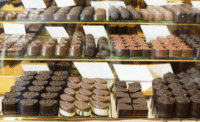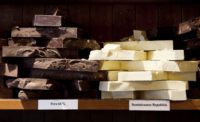American consumers may equally love chocolate, but not all chocolate is created equal.
Between the cocoa beans, additional ingredients, batch sizes and preparation methods, there are several variables that influence the overall quality — and the price.
But there’s another element that’s just as crucial as the chocolate’s ingredients and preparation, says self-described “chocolate doodler” Janet Straub, co-founder of award-winning Creo Chocolate: the history of the chocolate and the brand.
“As much as they can, I think that a maker needs to tell their story inside and out,” Straub said. “People can get a piece of chocolate everywhere, but not everybody can get your story and your passion.”
Passion is also a hallmark of super-premium chocolate, a category that has seen considerable growth in the United States, according to Maryland-based research firm Packaged Facts.
In the 11th edition of “Chocolate Candy Market in the U.S.,” Packaged Facts said sales of super-premium chocolate — which the firm defined as selling at more than $1.50 per ounce or more than $24 per pound — hit $55 million in 2016, up 15.4 percent from the year before. Unit sales reached 11 million, up 7.1 percent from 2015. That’s compared to the $1.9 billion premium chocolate market, which grew by 4.6 percent in 2016 and the $8.9 billion everyday chocolate market, which virtually stayed flat (0.3 percent) in 2016.
In addition to the view of premium chocolate as an “accessible indulgence,” Packaged Facts projected that “a strong pace of innovation, an influx of creative new players and a steady flow of new products that engage consumers” would push the U.S. chocolate market to approach $25 billion in 2020.
Norman Love, chocolatier and founder of Fort Myers, Fla.-based Norman Love Confections, cited increased education as a factor in consumers’ growing interest in chocolate, particularly in the the super-premium space.
“The whole American culinary movement has been moving north for 20 years now,” he said. “Chocolate is on board today. More artisans like myself are opening up around the country, helping to educate what true artisanal, true high-quality, handmade, ultra-premium chocolate is, along with a lot of bean-to-bar guys and ladies that are also opening in the United States and producing some great products,” he said.
And, as a result, consumers are willing to drop more on Love’s jewel-like chocolate pieces and other high-quality chocolate products.
“Our customers understand we’re more expensive than other boxed chocolates, but we’re buying the best ingredients, and we’re super labor-intense in making it by hand,” Love said. “For that, the ultra-premium should be more expensive.”
Denise Castronovo, founder and head chocolate maker at Stuart, Fla.-based Castronovo Chocolate, agrees. As an award-winning, bean-to-bar chocolate maker, she also pointed to the significance of a direct relationship with farmers and transparency in prices paid for cocoa.
“Cocoa is a labor-intensive crop that is also paradoxically sold as a commodity,” she said. “There is nothing mechanized in its harvest, fermenting, drying and packing. It all relies on human labor. So to drive the price down, the laborers are underpaid.”
Castronovo said her company pays three times more than commodity prices for their cocoa beans, which are heirloom varieties produced on small family farms or harvested in the wild. When the beans arrive in Florida, Castronovo Chocolate sorts them by hand, roasts them in small batches and grinds the chocolate for several days. The resulting 2.2-oz. bars, for which Castronovo charges $12-$14, are moulded and packed by hand.
“When you have chocolate of this caliber, it no longer falls into a category of candy,” she said. “It becomes a fine food like a wine or cheese,” she said. “What other luxury product can you purchase for under $15? Certainly not a top-shelf wine.”
Naturally, Jean-Philippe Khodara, founder and ceo of Forcalquier, France and Ojai, Calif.-based zChocolat, also compared fine chocolate to wine, noting discerning consumers require attention to detail.
“The French palate is as demanding with chocolate as it is with wine and has a definite preference for dark chocolate, smaller pieces (approximately 9 to 10 grams), less cream, less sugar and less butter,” he said. “When crafting each recipe, zChocolat takes all of this into account, demanding the most delicate yet bold flavors.”
Taking this approach, along with packaging chocolate pieces in personalized mahogany boxes, has captured American consumers.
“Gourmet chocolates seem expensive but their supreme quality, all natural ingredients and exceptionally unique presentation justify their price,” he said. “Consumers pay this price for chocolates handmade by a world champion chocolatier and 100 percent made in France,” he said.
In the hopes of improving the lives of cocoa farmers, Straub said Portland, Ore.-based Creo Chocolate pays two times the market price for heirloom cacao through a direct relationship with the Hacienda Limon in Ecuador. While that makes Creo’s bars more expensive, she said, consumers are technically getting more bang for their buck through cacao’s health benefits and longer flavor finishes.
“Because it’s not a recipe and I’m not hiding the flavor — it’s just cacao and sugar — the flavor has a long length of time,” she said. “An $8-$10 bar may cost more, but the flavors are going to linger.”
And Creo Chocolate enjoys playing with flavor. The company has introduced a 65% Whiskey Milk bar, which features cacao nibs barrel-aged with Portland whiskey before being crafted into creamy dark milk chocolate and sprinkled with mesquite-smoked sea salt. Similarly, Creo’s 67% Brown Butter bar brings distinctive honey and toffee flavor notes, balanced with the nutty flavor of house-browned butter.
And, in dedication of Straub’s fight with breast cancer, Creo developed the Hope bar, which features white chocolate colored and flavored with purple hibiscus petals. Slices of freeze-dried strawberries are sprinkled on top.
Creating the bar has allowed Straub to share her experience with others whose lives have been touched by breast cancer.
“Food in general connects people,” she said. “People buy chocolate to celebrate things. They buy it because they need a moment with chocolate and Kleenex, or they buy it to cheer someone up. (This bar) is another way of connecting with people because so many people are affected by it. I know I’m not alone.”
Love also understands the emotional connection to food. When he founded his company in 2001, Love’s goal was to use flavor profiles that his customers were sure to appreciate and enjoy.
For Valentine’s Day 2018, Norman Love introduced the Sweetie Pie collection — heart-shaped pieces in traditional, comfortable pie flavors such as Peanut Butter Chocolate, Grasshopper, Lemon Meringue, Coconut Cream and Pumpkin, among others. And for Easter 2018, Norman Love released a collection of egg crèmes patterned off egg cream soda flavors.
“Make flavors that are identifiable, execute them perfectly and make sure that they’re easily related,” he said.
Whether chocolate’s unique flavors are celebrated in a single-origin bar or are precisely paired with other ingredients, dedication to quality is sure to keep consumers coming back — and spending — for more.









